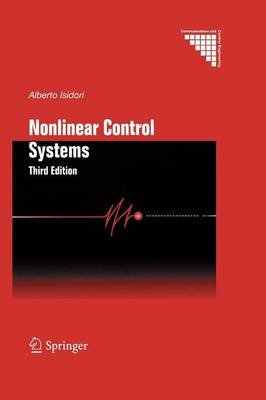
Stock image for illustration purposes only - book cover, edition or condition may vary.
Nonlinear Control Systems
Alberto Isidori
FREE Delivery in Ireland
Description for Nonlinear Control Systems
Paperback. Series: Communications and Control Engineering (Paperback). Num Pages: black & white illustrations, bibliography. BIC Classification: GPFC; PBF; PBKA; PBUH; PBW; PD; THR; TJFM1; TRC. Category: (G) General (US: Trade). Dimension: 234 x 156 x 29. Weight in Grams: 785.
The purpose of this book is to present a self-contained description of the fun- damentals of the theory of nonlinear control systems, with special emphasis on the differential geometric approach. The book is intended as a graduate text as weil as a reference to scientists and engineers involved in the analysis and design of feedback systems. The first version of this book was written in 1983, while I was teach- ing at the Department of Systems Science and Mathematics at Washington University in St. Louis. This new edition integrates my subsequent teaching experience gained at the University of Illinois in ... Read moreUrbana-Champaign in 1987, at the Carl-Cranz Gesellschaft in Oberpfaffenhofen in 1987, at the University of California in Berkeley in 1988. In addition to a major rearrangement of the last two Chapters of the first version, this new edition incorporates two additional Chapters at a more elementary level and an exposition of some relevant research findings which have occurred since 1985. Show Less
Product Details
Publisher
Springer London Ltd
Series
Communications and Control Engineering (Paperback)
Place of Publication
England, United Kingdom
Shipping Time
Usually ships in 15 to 20 working days
About Alberto Isidori
Alberto Isidori was born in Rapallo, Italy. He graduated in electrical engineering from the University of Rome in 1965. In 1969 he obtained a degree equivalent to a doctorate in automatic control from the University of Rome. Since 1975, he has been Professor of Automatic Control at the University of Rome La Sapienza . ... Read moreSince 1989, he has also held a position of rofessor (on a half-time basis) at the Department of Systems Science and Mathematics, Washington University, St. Louis, Missouri. He has held visiting positions at several academic institutions, including the University of Illinois (Urbana, Il.), the University of California (Berkeley, Ca.) and the ETH (Zurich, Switzerland). His research interests are primarily focused on mathematical control theory and control engineering. In 1979, Alberto Isidori initiated a research program aimed at the extension of so-called geometric theory of multivariable linear systems, pioneered in the early 1970s by various authors,to linear systems. Linear algebra and linear geometric methods were replaced in nonlinear systems by the methods of differential geometry, whose usefulness in the study of controllability, observability, and minimality of nonlinear systems had been demonstrated in the early 70s. The main intuition of Isidori was to use differential geometric methods in the synthesis of feedback laws for nonlinear systems, more or less in the same way as linear geometric methods were used in the synthesis of feedback laws for linear systems. The result of this seminal work was the development of systematic methods addressing outstanding design problems like feedback linearization, noninteracting control, disturbance decoupling, and model matching. From 1985 to 1990 Isidori's research concentrated on the development of the nonlinear analogue of the notion of the zero of a transfer function. Taking as a point of departure the geometric interpretation of this notion, the concept of nonlinear zero dynamics was introduced, studied, and applied. As a result, it was shown that most of the features of the notion of zeros of the transfer function of a linear system are actually manifestations of more general principles. Remarkable examples of application of this theory consisted in the study and the solution of the nonlinear equivalent of the so-called servomechanism problem of linear system theory and in the characterization of the conditions for feedback equivalence to a nonlinear passive system. Since the 90s, Isidori has focused his research interests on problems of disturbance attenuation and robust stabilization of nonlinear systems. Professional Activities -President of the European Union Control Association (1995-1997). -Member of the IFAC Council (1993-1996). -President-elect of IFAC (three-year term to begin following IFAC World Congress in Seoul 2008) -On the Editorial Board of: European Journal of Control (since 1995), Automatica (since 1990), IEEE Transactions on Automatic Control (since 1990), International Journal of Control (since 1990), International Journal of Robust and Nonlinear Control (since 1991), Journal of Mathematical Systems, Estimation and Control (since 1991), Mathematics of Control, Signals and Systems (1987-89), Applied Stochastic Models and Data Analysis (since 1985), Systems and Control Letters (1981-88). Awards and Honors -Georgio Quazza Medal of IFAC, for ?pionering and fundamental contributions to the theory of nonlinear control,? 1996. -Fellow of the Institute of Electrical and Electronic Engineers, for ?fundamental contributions to nonlinear control theory?, 1987. -Outstanding Paper Award for papers published on IEEE Transactions on Automatic Control, in 1981 and in 1990. -Outstanding Paper Award a paper published on Automatica in1991. Selected Publications Nonlinear Control Systems (3rd edition), Springer Verlag (1995), pp. 1-549. Topics in Control Theory, with W. Knobloch and D. Flockerzi, Berkhauser (1993), pp. 1-166. Output Regulation of Uncertain Nonlinear Systems, with C.I. Byrnes and F. Delli Priscoli, Birkhauser (1997), pp. 1-122. Trends in Control Theory (editor), Springer Verlag (1995), pp. 1-422. Systems, Models and Feedback (co-editor, with T.J. Tarn), Birkhauser (1992), pp. 1-402. Show Less
Reviews for Nonlinear Control Systems
From the reviews: Isidori's book is essential for anyone preparing for serious reading or basic research in the differential geometric approach to control theory and will not disappoint those mathematically trained. I have observed its use in the hands of two teachers other than the author; the students enjoyed it and made good use of ... Read moreit later. There is no universal solvent for nonlinear control problems, but the methods presented here are powerful. IEEE Transactions on Automatic Control 43 (1997) 1043-1044 (Reviewer: David L. Elliott) Show Less

